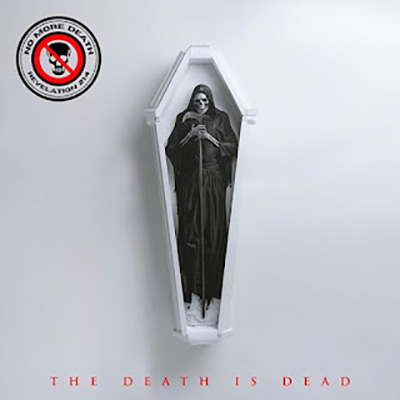When the world seems to be spinning on the edge of some cosmic breakdown, thrash metal always finds a way to sound like the perfect soundtrack. São Paulo, Brazil, is no stranger to exporting musical aggression, but even within this heavy tradition, No More Death’s debut, “The Death Is Dead,” feels like the arrival of something both raw and refined—a paradox that only thrash can deliver. Released independently on July 4, 2025, this eight-track, 37-minute whirlwind is the brainchild of Tiago Torres, known for his uncompromising work with the now-retired Mad Dragzter. Here, Torres doesn’t just revisit old ground; he grinds it into something new and vital, with the album’s apocalyptic energy making a statement that can’t be ignored.
 Tiago Torres isn’t a stranger to the Brazilian metal faithful. As the founder, guitarist, and vocalist of Mad Dragzter, he helped define a distinctly melodic-yet-ferocious thrash sound throughout the 2000s. Mad Dragzter earned a cult following for albums that mixed speed, aggression, and thoughtful lyricism—a formula Torres has carried forward, but with a more apocalyptic and introspective edge in No More Death.
Tiago Torres isn’t a stranger to the Brazilian metal faithful. As the founder, guitarist, and vocalist of Mad Dragzter, he helped define a distinctly melodic-yet-ferocious thrash sound throughout the 2000s. Mad Dragzter earned a cult following for albums that mixed speed, aggression, and thoughtful lyricism—a formula Torres has carried forward, but with a more apocalyptic and introspective edge in No More Death.
No More Death, formed in 2024, is more than a solo project. Torres recorded all guitars, vocals, and bass for “The Death Is Dead,” pouring his decades of experience into every riff and lyric. The creative vision is cohesive, yet the album never feels insular; instead, it’s bursting with the urgency and collaborative spirit that defined his best work.
The album begins with its title track, “The Death Is Dead,” setting a tone of relentless speed and existential rumination. The song’s breakneck riffs and pounding rhythms are matched by lyrics that crack open the mysteries of mortality, faith, and survival.
From there, the album doesn’t let up. “The Glory” stretches past the six-minute mark, building from a slow-burn intro into a galloping, riff-heavy assault. Reviewers have compared the album’s sound to mid-’80s Metal Church, with a modern clarity and a distinctly Brazilian undercurrent.
“Great White Throne” and “Forever Young” push the melodic side, with catchy choruses and harmonized leads that recall the golden age of thrash, while “Sons of Light” and “Annihilated” deliver a more savage, staccato attack. “Dreams About Eternity” is arguably the album’s most ambitious track, weaving complex rhythms and spiritual themes in a way that doesn’t feel forced or cliché. The closer, “Love Is Immortal,” ends the record with a surprising emotional punch, embracing hope amid the chaos.
Tracklist:
- The Death Is Dead – 3:50
- The Glory – 6:12
- Great White Throne – 4:50
- Forever Young – 4:28
- Sons of Light – 4:58
- Annihilated – 3:04
- Dreams About Eternity – 4:46
- Love Is Immortal
“The Death Is Dead” doesn’t just sound apocalyptic; it looks the part, too. The album cover, created by Jeam Michel (@designationsartwork), who has worked with Metal Church, Queensrÿche, George Lynch, and others, is a visual feast—dark, detailed, and rich with symbolism. Michel’s covers are known for their narrative power, and here he delivers a piece that matches the album’s themes of mortality and transcendence.
While thrash metal is known for its aggression, No More Death carves out a unique space by exploring spiritual themes without sacrificing heaviness. The lyrics traverse traditional thrash territory—apocalypse, struggle, inner demons—but through the lens of faith and hope. This doesn’t mean the album preaches; rather, it uses the genre’s intensity to grapple with questions of life, death, and what comes after. The approach has drawn praise from both secular and Christian metal circles for its honesty and refusal to sugarcoat reality.
Since its release, “The Death Is Dead” has been met with enthusiasm from both fans and critics. Heaven’s Metal Magazine called it “an apocalyptic thrash opus drenched in breakneck riffs, pounding rhythms, and lyrics that crack open the mysteries of mortality”. On Reddit’s r/christianmetal, listeners praised its unique sound, which “reminds me of the way Metal Church was right smackdab in the grey area between thrash and something more melodic”.
The fact that Tiago Torres handled nearly every instrument and vocal has only added to the album’s mystique, with some fans comparing his one-man-band approach to that of Chuck Schuldiner’s work in Death—though No More Death’s vibe is more rooted in classic thrash than technical death metal.
Releasing independently in 2025 means navigating a landscape where Spotify playlists, Bandcamp communities, and social media shoutouts are as vital as traditional press. No More Death has embraced this, using their online presence to connect directly with fans and share the album’s message. The band’s social media channels are filled with behind-the-scenes content, lyric explanations, and direct interaction—helping to build a grassroots following that feels as passionate as any old-school street team.
Brazil is no stranger to metal. From Sepultura’s global dominance to the underground scenes in Belo Horizonte and São Paulo, the country has always produced bands that mix technical prowess with raw energy. No More Death fits squarely into this tradition but also pushes it forward—bringing a uniquely spiritual and introspective dimension to the Brazilian thrash scene.
As of July 2025, No More Death are riding the wave of their debut’s success. Reviews keep rolling in, and fans are eager for live dates and future releases. Tiago Torres, never one to sit still, is already hinting at new material and potential collaborations. If “The Death Is Dead” is any indication, No More Death’s next moves will be worth watching—both for longtime fans of Brazilian thrash and for anyone looking for metal that dares to ask the big questions.
The Death Is Dead by No More Death



